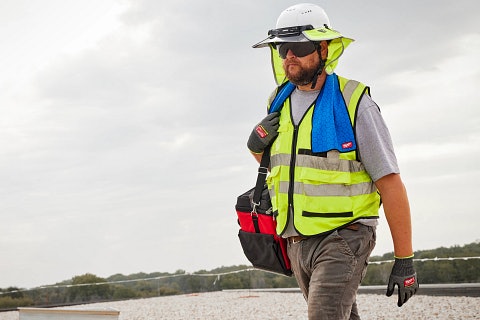As temperatures rise and work environments grow more demanding, the need for reliable temperature-regulating personal protective equipment and workwear has never been greater. Whether indoors with limited ventilation or outdoors under direct sun exposure, heat stress poses a serious risk to worker health, safety, and productivity. Prolonged exposure to high temperatures can lead to fatigue, dehydration, heat exhaustion, or more severe conditions like heat stroke.
Organizations such as the Occupational Safety and Health Administration (OSHA) continue to raise awareness around heat-related illnesses, encouraging employers to adopt preventive strategies— temperature-regulating gear among them. From moisture-wicking fabrics to cooling evaporative gear, temperature-regulating gear is quickly shifting from a comfort feature to a jobsite necessity.
How Heat Stress Impacts Productivity
Heat stress poses a significant threat to worker productivity, particularly in labor-intensive sectors like construction. As the body struggles to regulate its core temperature under extreme heat, workers experience fatigue, diminished concentration, and slower reaction times. These physiological responses not only increase the risk of accidents but also lead to a measurable decline in work output.
Mitigation Strategies
Staying cool on the jobsite is about more than comfort—it’s a cornerstone of safety. As temperatures rise, so does the body’s internal workload. To maintain a stable core temperature, the body redirects energy toward thermoregulation, which can impair physical and mental performance.
On high-exertion jobs like construction, where workers are already exposed to direct sunlight, limited airflow, and heavy personal protective equipment, staying cool becomes critical. Without proactive cooling strategies in place, workers may experience reduced reaction time, poor decision-making, and increased exposure to injury—not just posing a risk to themselves, but to those around them.
What does staying cool actually look like on today’s jobsites?
It includes a mix of practical solutions:
· Access to Hydration and Recovery: Regular hydration, jobsite fans and breaks in shaded or air-conditioned areas allow the body time to recover.
· Smart scheduling: Shifting the most strenuous tasks to earlier or later in the day when temperatures are lower.
· Training and awareness: Helping workers and supervisors recognize early symptoms of heat stress and take immediate action.
· Cooling gear: Lightweight, breathable clothing; moisture-wicking base layers; evaporative accessories like towels, helmet liners, and vests.
By integrating these elements into a heat safety plan, employers can better protect workers while also supporting steady performance across the day. Cooling isn’t a luxury—it’s a safety tool. And as jobsite conditions grow more extreme, it’s becoming a non-negotiable part of personal protective equipment planning.
Wearable Solutions for Managing Heat on the Job
Temperature-regulating gear is available in a variety of forms, each designed to help cool body temperature and manage heat exposure on the job.
· Personal Protective Equipment: Cooling personal protective equipment is designed to provide fast, lightweight relief in high-heat environments. With significant advancements in temperature-regulating personal protective equipment for construction professionals, some manufacturers have invested in the continued investment and expansion of cooling solutions.
· Workwear: Workwear is designed to help regulate body temperature through fabrics that pull sweat away from the skin, promote airflow, dry quickly, and keep workers comfortable in high heat environments.
Temperature-regulating gear comes in a range of forms, each designed to combat heat stress through different ways. Whether layered for all-day coverage or used intermittently for relief, this modern gear is built to support the unique challenges of construction work—helping crews stay safer and more productive through even the hottest workdays.
Trends in Cooling Personal Protective Equipment
The future of temperature-regulating gear is being shaped by continuous innovation in both technology and design. As extreme heat becomes a more consistent challenge, manufacturers are responding with new materials and designs aimed at enhancing comfort, safety, and performance on the jobsite.
Lightweight, UV-resistant, and moisture-managing fabrics are becoming more common, reflecting a shift from basic protective gear to integrated solutions that support workers through longer, hotter shifts.
Perhaps most notably, cooling technology adoption is accelerating on job sites. Construction employers are recognizing that investing in heat stress prevention improves safety outcomes, boosts morale, and increases productivity—making temperature-regulating gear a smart addition to any jobsite safety plan.
Practical Considerations for Workers and Employers
Selecting the right gear means matching it to the jobsite’s specific demands. Consider fit (for comfort and mobility), material (for breathability and performance), and reactivation needs (especially for evaporative gear).
Some products are designed for short bursts of relief; others are built for all-day wear under full personal protective equipment. Employers should evaluate how gear supports shift length, site conditions, and worker preferences.
Beyond gear selection, employers play a vital role in ensuring effective heat stress prevention. OSHA emphasizes the importance of providing appropriate personal protective equipment and implementing workplace policies that account for extreme temperatures. This includes training crews on recognizing signs of heat-related illness and integrating temperature-regulating gear into a broader safety strategy. As temperatures continue to rise, proper selection and deployment of this gear is becoming a standard part of jobsite readiness.
Conclusion
In conclusion, the impact of heat stress on workers is a pressing concern that demands immediate attention. By understanding the relationship between high temperatures and work performance, and by implementing effective mitigation strategies, industries can better navigate these challenges, even on the hottest days.
View the original article and our Inspiration here


Leave a Reply